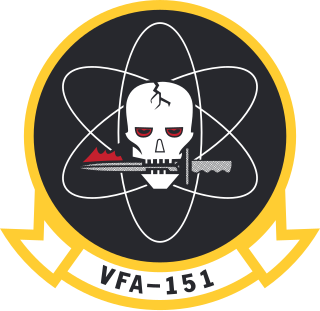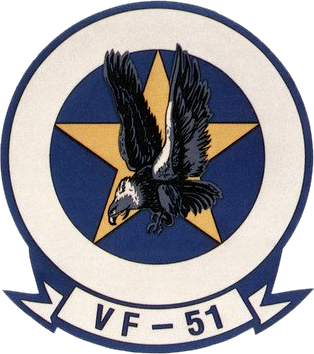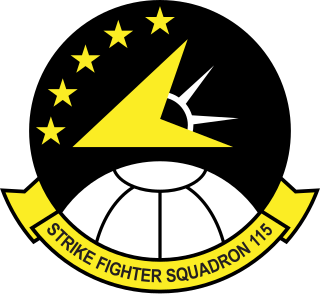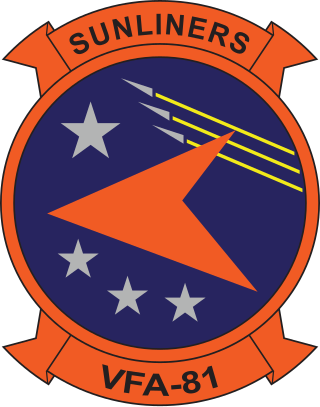
Strike Fighter Squadron 211 (VFA-211), nicknamed the "Fighting Checkmates", is an aviation unit of the United States Navy established in 1945. The squadron is based at Naval Air Station Oceana and is equipped with the Boeing F/A-18E Super Hornet.

Fighter Squadron 213 (VF-213)

A carrier air wing is an operational naval aviation organization composed of several aircraft squadrons and detachments of various types of fixed-wing and rotary-wing aircraft. Organized, equipped and trained to conduct modern US Navy carrier air operations while embarked aboard aircraft carriers, the various squadrons in an air wing have different but complementary missions, and provide most of the striking power and electronic warfare capabilities of a carrier battle group (CVBG). While the CVBG term is still used by other nations, the CVBG in US parlance is now known as a carrier strike group (CSG).

Strike Fighter Squadron One Five One (VFA-151) nicknamed the Vigilantes are a United States Navy F/A-18E Super Hornet fighter squadron stationed at Naval Air Station Lemoore, California. The squadron is a part of Carrier Air Wing 9 (CVW-9). As part of CVW-9, the squadron's tail code is NG and its radio callsign is "Ugly".

VF-51, Fighter Squadron 51 was an aviation unit of the United States Navy known as the "Screaming Eagles". It was originally established as VF-1 on 1 February 1943, redesignated as VF-5 on 15 July 1943, redesignated as VF-5A on 15 November 1946, redesignated VF-51 on 16 August 1948, and disestablished in March 1995. Until its disestablishment, VF-51 was the oldest fighter squadron in continuous service with the Pacific Fleet.

Fighter Squadron 114 (VF-114) was a fighter squadron of the United States Navy that was active from 1945 through 1993. Nicknamed the "Aardvarks", it was based out of Naval Air Station Miramar, California. The squadron flew combat missions during the Korean War and Vietnam War. VF-114 was disestablished as part of the post-Cold War drawdown of forces on 30 April 1993.

Strike Fighter Squadron 154 (VFA-154), also known as the "Black Knights", is a United States Navy strike fighter squadron stationed at Naval Air Station Lemoore. The Black Knights are an operational fleet squadron flying the F/A-18F Super Hornet. They are currently attached to Carrier Air Wing Eleven and deployed aboard the aircraft carrier USS Theodore Roosevelt. Their tailcode is NH and their callsign is "Knight".

Strike Fighter Squadron 115 (VFA-115) is known as the "Eagles", callsign "Talon", a United States Navy F/A-18E Super Hornet strike fighter squadron stationed at Marine Corps Air Station Iwakuni. Their tail code is NF. It was established as Torpedo Squadron VT-11 on 10 October 1942, redesignated VA-12A on 15 November 1946, VA-115 on 15 July 1948, then finally VFA-115.

Strike Fighter Squadron 94 (VFA-94), also known as the Mighty Shrikes, is a United States Navy fighter squadron stationed at Naval Air Station Lemoore. It is an operational fleet squadron currently flying the F/A-18E Super Hornet. It is attached to Carrier Air Wing 17 and based at NAS Lemoore, California. Its tail code is "NA" and its radio call sign is "Hobo".

Attack Squadron 65 (VA-65), nicknamed The World Famous Fighting Tigers, was an attack squadron of the United States Navy. The squadron was established as Torpedo Squadron VT-74 in 1945, redesignated as VA-2B in 1946, as VA-25 on 1 September 1948, and finally redesignated VA-65 on 1 July 1959. It was disestablished in 1993. Known as "The World Famous Fighting Tigers", VA-65 was one of the last medium attack squadrons to fly the A-6 Intruder and the A-1 Skyraider. It was the second squadron to be designated VA-65, the first VA-65 was redesignated from VA-6B on 27 July 1948 and would be redesignated as VA-25 on 1 July 1959.

Strike Fighter Squadron 195 (VFA-195), also known as the "Dambusters", is a United States Navy F/A-18E Super Hornet fighter squadron stationed at Marine Corps Air Station Iwakuni, Japan. They are a part of Carrier Air Wing Five (CVW-5) and their tail code is NF. Their radio callsign is "Chippy".

Strike Fighter Squadron 113 (VFA-113), also known as the "Stingers," is a United States Navy strike fighter squadron based at Naval Air Station Lemoore, California. They are an operational fleet F/A-18E Super Hornet squadron attached to Carrier Air Wing 2 (CVW-2) and based at NAS Lemoore, California. Their tailcode is NE and their radio callsign is Sting.

Strike Fighter Squadron 81 (VFA-81), also known as the "Sunliners", is a United States Navy F/A-18E Super Hornet strike fighter squadron stationed at Naval Air Station Oceana. They are currently assigned to Carrier Air Wing 1. Their mission is to conduct prompt and sustained combat operations from the sea. The squadron was originally designated VA-66 on 1 July 1955, was redesignated VF-81 the same day, redesignated VA-81 on 1 July 1959, and finally redesignated VFA-81 on 4 February 1988.

Strike Fighter Squadron 192 (VFA-192), also known as the "World Famous Golden Dragons", are a United States Navy F/A-18E Super Hornet fighter squadron stationed at NAS Lemoore.

Carrier Air Wing Five (CVW-5) is a United States Navy aircraft carrier air wing based at Marine Corps Air Station Iwakuni. The air wing is attached to the aircraft carrier USS Ronald Reagan. It was initially formed in 1943. It has participated in the Second World War, the Korean War, the Gulf War, Operation Southern Watch, the War in Afghanistan, and the War in Iraq.

Carrier Air Wing Eleven (CVW-11) is a United States Navy aircraft carrier air wing based at Naval Air Station Lemoore, California. The air wing is attached to the aircraft carrier USS Theodore Roosevelt.

Attack Squadron 145 (VA-145) was an aviation unit of the United States Navy, nicknamed the Rustlers from 1951-1954, and the Swordsmen thereafter. The squadron was established as Reserve squadron VA-702 on 1 December 1949, and called to active duty on 20 July 1950. It was redesignated VA-145 on 4 February 1953, and disestablished on 1 October 1993.

VA-165, nicknamed the Boomers, was a long-lived Attack Squadron of the U.S. Navy. It was established on 1 September 1960, and disestablished 35 years later on 30 September 1996. The squadron operated in the region of Vietnam, Laos, and Korea during the 1960s and early 1970s. VA-165 transferred to the Persian Gulf after the 1973 Yom Kippur War, and also served near the Philippines during the late 1970s. During the 1980s, VA-165 was moved from the Middle East to Central America, particularly Nicaragua, back to Iran in the Middle East, off to South Korea, and then to the Middle East again for Kuwait. During the 1990s, the squadron worked in the United States, the Middle East, and Taiwan.

Attack Squadron 196 (VA-196) was an aviation unit of the United States Navy. It was established as Fighter Squadron 153 (VF-153) on 15 July 1948, redesignated as VF-194 on 15 February 1950, and finally redesignated VA-196 on 4 May 1955. Its nicknames were the Thundercats from 1948 to the 1950s, and The Main Battery from the 1950s thereafter. Beginning in 1979 the squadron used the nickname Milestones interchangeably with Main Battery. The squadron was disestablished on 21 March 1997, after more than 48 years of service.

Carrier Air Wing Fifteen (CVW-15) is a former United States Navy aircraft carrier air wing that was decommissioned on 31 March 1995. It was previously known as Carrier Air Group Fifteen (CVG-15) before 1963 before being renamed in December of that year.
























